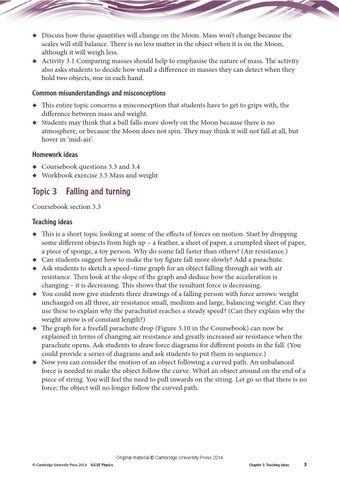◆
◆
Discuss how these quantities will change on the Moon. Mass won’t change because the scales will still balance. There is no less matter in the object when it is on the Moon, although it will weigh less. Activity 3.1 Comparing masses should help to emphasise the nature of mass. The activity also asks students to decide how small a difference in masses they can detect when they hold two objects, one in each hand.
Common misunderstandings and misconceptions ◆ ◆
This entire topic concerns a misconception that students have to get to grips with, the difference between mass and weight. Students may think that a ball falls more slowly on the Moon because there is no atmosphere, or because the Moon does not spin. They may think it will not fall at all, but hover in ‘mid-air’.
Homework ideas ◆ ◆
Coursebook questions 3.3 and 3.4 Workbook exercise 3.5 Mass and weight
Topic 3
Falling and turning
Coursebook section 3.3 Teaching ideas ◆
◆ ◆
◆
◆
◆
This is a short topic looking at some of the effects of forces on motion. Start by dropping some different objects from high up – a feather, a sheet of paper, a crumpled sheet of paper, a piece of sponge, a toy person. Why do some fall faster than others? (Air resistance.) Can students suggest how to make the toy figure fall more slowly? Add a parachute. Ask students to sketch a speed–time graph for an object falling through air with air resistance. Then look at the slope of the graph and deduce how the acceleration is changing – it is decreasing. This shows that the resultant force is decreasing. You could now give students three drawings of a falling person with force arrows: weight unchanged on all three, air resistance small, medium and large, balancing weight. Can they use these to explain why the parachutist reaches a steady speed? (Can they explain why the weight arrow is of constant length?) The graph for a freefall parachute drop (Figure 3.10 in the Coursebook) can now be explained in terms of changing air resistance and greatly increased air resistance when the parachute opens. Ask students to draw force diagrams for different points in the fall. (You could provide a series of diagrams and ask students to put them in sequence.) Now you can consider the motion of an object following a curved path. An unbalanced force is needed to make the object follow the curve. Whirl an object around on the end of a piece of string. You will feel the need to pull inwards on the string. Let go so that there is no force; the object will no longer follow the curved path.
Original material © Cambridge University Press 2014 © Cambridge University Press 2014 IGCSE Physics
Chapter 3: Teaching ideas
3
